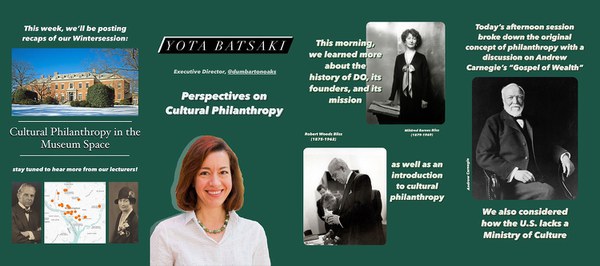By Alexis Boo
On January 11, we launched our annual Wintersession course, “Cultural Philanthropy in the Museum Space.”
The five-day virtual course introduced ten Harvard undergraduate and graduate students to the history, contemporary influence, and key debates surrounding philanthropy, with a special focus on its relationship to museums. The United States stands out for its comparatively decentralized model of support for the arts and culture, which means philanthropic giving exerts tremendous influence on the sector. Guest speakers from institutions such as the Smithsonian, the Getty, and the George Washington University Museum and The Textile Museum discussed with students the shifting landscape of cultural philanthropy in our historical moment, defined by the pandemic and by movements to combat social inequality and injustice.
In past years the course took place at Dumbarton Oaks and included numerous external site visits, but this January students and speakers Zoomed in from across the country. Although joining remotely, students still had the opportunity to engage with speakers and their peers throughout the week. Conversations about the current challenges of arts organizations felt all the more poignant as people who are devoted to material culture and physical access to collections had to use digital modes of interaction and sharing.
The course opened with a broad historical overview of the perspectives on cultural philanthropy, as well as an introduction to Dumbarton Oaks by course organizer Yota Batsaki. Stanley Katz, president emeritus of the American Council of Learned Societies, and New York University research fellow Leah Reisman launched the afternoon discussion into the present by detailing the extreme pressures imposed by the pandemic on cultural organizations, focusing on Philadelphia. The speakers analyzed the consequences of the current funding and revenue crisis, especially for smaller organizations and for groups working to promote, advance, and support minority culture, arts, and rights, which are fighting for survival. This disproportionately negative impact on smaller organizations is all the more concerning at a time when large institutions face mounting pressure to respond to legacies of inequality and social injustice.
Students also learned about the significant but little-known contributions to cultural philanthropy by historically marginalized groups. Women have played a critical role in supporting the arts, politics, and scientific research in the United States, even when they lacked financial independence. Black community organizations were instrumental in supporting and exhibiting work by Black artists. Patricia Banks, a professor of sociology at Mount Holyoke College, shared her research on philanthropy as a vehicle for identity formation, by showing how not only class, but also race, profession, lifestyle, or age affect philanthropic practices and goals.
Seminars explored other dimensions of philanthropy such as funding, the physical museum space, and the role of boards and governance. Students learned about the network of individuals that shapes the mission and direction of a museum. They were also encouraged to think critically about shifting frameworks of philanthropy throughout US history. While strategic philanthropy has been a key driver during the last two decades, some of its tenets go back a hundred years or more to philanthropic manifestos by Andrew Carnegie and Julius Rosenwald, among others. Recently we are beginning to see a shift from a strategic to a trust-based philanthropic model that emphasizes the voices and autonomy of the communities served by giving.
At a time when giving is crucial to the survival of many cultural organizations, it is especially important for young scholars of the humanities to understand philanthropy’s history and potential impact. Amanda Moniz, curator of philanthropy at the National Museum of American History, encouraged us to consider the question of how Americans motivate, solicit, and sell generosity. Students looking to engage professionally with the arts have a stake in philanthropy and should continue thinking about how it manifests in the museum space, as well as in the greater sphere of the humanities.
Alexis Boo was the 2021 Wintersession intern.

